Friday
Featured Stories, Sakyong and FamilyThe Blazing Warmth of Generosity
How generosity manifests at the Gongter ceremonies
by Walker Blaine
Large Buddhist programs in Asia are primarily supported by major patrons, rather than by the collective sponsorship of all the participants’ program fees which is generally the case in the West. This means that an entire event is already funded before people are sitting on their cushions. Anyone who wants to attend the program is welcome, although food is not always provided, and housing is left to the individual to find. Many of the major monasteries in Asia have guesthouses and there are usually other places to stay nearby too.
Any description of an event as momentous as the Gongter would be incomplete without a description of how generosity manifests in the Asian dharmic world. Like programs in the West, the Gongter had teachings, meals, and opportunities to make connections with the teacher and dharmic friends. However, there is a different manner in which Buddhist events arise in Asia and the contrast will be interesting to anyone who hasn’t participated in a retreat like the Gongter.
This does not mean the teachings are free. At the end of the Gongter, there was an opportunity for all who received the empowerments to make offerings to the teachers in gratitude and support of their activities. This is an expression of kor, which is the Tibetan word for the cycle of generosity that revolves between the teacher and student. The student offers to the teacher, who in turn teaches the student, or does practices to overcome obstacles, enrich situations, and so forth on the student’s behalf. It is up to the teacher to use the offerings properly and also to do whatever practice they have committed to doing for the student. It is up to the student to follow the teacher’s instructions and do whatever practice they have received from the teacher. Kor is a powerful expression of positive karma benefiting in all directions at once.
The primary disciple receiving the Gongter from His Eminence was Sakyong Mipham Rinpoche. For Shambhalians at the retreat, this was an opportunity to see their teacher in the role of both patron and student offering in order to receive the teachings. The Sakyong and Sakyong Wangmo, together with Semo Palmo and her husband Alan, and other major donors co-sponsored the Gongter after the Sakyong initially requested the teachings from Namkha Drimed Rinpoche.
This kind of support from major donors echoes the tradition of royal patronage of the teachings, and harkens back to the time of the Buddha. During that era, and throughout the expansion of Buddhism up to the present time, people with great means and ability have made it possible for the community of practitioners to grow; for monasteries, colleges, and great places of pilgrimage to be constructed; for great works of art and literature to be composed and published; and for many beneficial public works, such as the construction of roads and hospitals, and the distribution of food, water, and other necessities. Biographies of lineage figures are filled with stories of amazing offerings given by both teacher and patron, such as the iron bridges constructed all over Tibet and Bhutan by Tangtong Gyalpo in the 14th and 15th centuries.
The ways that generosity manifested at the Gongter were remarkable to watch. Besides providing tented housing for Tibetans who traveled a great distance, the monastery offered lunches for everyone at the retreat—some 2,000 people at one point—by means of a massive outdoor kitchen built in a lower courtyard. The cooking pots of rice and curries were so large that two people had to carry them from the wood-fired stoves in the lower monastery to the upper courtyard where most of the laypeople and the general population of monks and nuns were fed. Through a culinary miracle, the more people who arrived for the empowerments, the better the curries seemed to become, even though the capacity of the monastery was clearly close to its limit.
The place where generosity was most visible, and even celebrated, was during the morning and afternoon teas held during the mid-session breaks in the reading transmissions and empowerments. Virtually all of the mangja, or collective teas, at the Gongter were sponsored by an individual or a group. One of the first was sponsored by the Sakyong and Sakyong Wangmo. The mangja all involved an aspiration read aloud to His Eminence and the assembly. This was a time when the principal teacher and students at the event were formally asked to practice in order to realize the aspiration. It was remarkable to witness the attention that Namkha Drimed Rinpoche and the other teachers gave to listening to the aspirations as they were read.
The mangjas in particular were a unique way for people to offer money to a dharmic cause, because during a mangja not only is the tea sponsored, but money is offered to the teachers and monastics to support their life and practice. This was meaningful to the monastics, especially the younger ones, who sometimes did not have spending money. The sponsors of a mangja would present the entire Ripa lineage and monastics with small amounts of money. Amazingly, part of the mangja tradition is for the amount given to each person to be announced aloud. This skillful style of transparency is intended to overcome both pride and jealousy since everyone knows who is getting what. Western practitioners sometimes received a small monetary gift as well. This meant everyone was involved in the cycle of generosity, sometimes as the offerer, and sometimes as those offered to, but always practicing for the benefit of His Eminence and the patron’s aspirations.
Interestingly, the tea and snack itself was served as the empowerment or lung was happening. First monks, or sometimes Tibetan lay practitioners, moved through the aisles with boxes of treats. These sometimes had amusing brand names and slogans, such as “Karmacharya,” which means master of activity, or “Freak – Lightly salted and fresh.” Then the tea would come, served from piping hot kettles that seemed too hot and large for anyone to be carrying through a crowded shrineroom. Amazingly, I never saw a single spill during the whole Gongter. At first we had Tibetan butter tea, black tea and butter with salt added. For some, this was an intense beverage in the summerish heat that beat down on Parpeng at the start of the program, but after a few days the monastery began serving sweet chai-style tea.
After the tea and snack was served, short offering verses were recited before we began eating. During the empowerments with His Eminence, the mangja often transitioned into a formal tenshuk, or request for the teacher’s life and activity to remain firm. Tenshuks are ceremonies where the students request that the teacher continue to teach, have a healthy and long life, and continue to permeate the world with enlightened activity. In the spirit of kor, this request is made after offering representations of the entire universe, symbolic of the entire kingdom of a universal monarch, followed by representations of enlightened body, speech, mind, quality, and activity. Tenshuks usually happen at the end of vajrayana teachings, so it was significant to be offering them throughout the Gongter, sometimes two or three in a row. As the Gongter progressed we saw that the groups offering the tenshuk were the different communities with which His Eminence had connections. They became a way to learn who was who, as well as being a time for everyone to make aspirations collectively.
The final tenshuks at the Gongter were especially grand. At some, exquisite statues that were years in the making were presented to His Eminence. I was in the receiving area outside Namkha Drimed Rinpoche’s chambers when one of these statues was sneaked into the monastery by the sculptor and his daughter. Seeing them I realized that offerings like these provided livelihood for some of the most skilled craftspeople in the region, while simultaneously preserving artistic disciplines that are among humanity’s greatest treasures. Another example of the cycle of generosity continuing.
Of course, His Eminence was the most generous being at the Gongter. All of his spiritual treasures were offered to everyone at the teachings, and his monastery was expressing its generosity as host and patron only as a manifestation of Namkha Drimed Rinpoche’s compassionate activity in the world. All of these expressions of kindness created a wonderful atmosphere of gentleness and inspiration, which shone more and more brightly in everyone’s eyes as the Gongter progressed. Whether Tibetan, Nepali, Bhutanese, Malaysian, Taiwanese, or from the West, we each saw that light in each other throughout the Gongter. This light of generosity and wisdom created a huge family of dharma around His Eminence in Parpeng.
Walker Blaine is Master of Liturgies to Sakyong Mipham Rinpoche. He has studied extensively with the Sakyong and been part of the Shambhala community for more that 30 years. Walker’s ebook, The Great River of Blessings an account of the Rinchen Terdzö received by Sakyong Mipham Rinpoche in the winter of 2008-2009, can be downloaded at the Sakyong Foundation. Walker lives with his wife Patricia in Halifax, Nova Scotia.

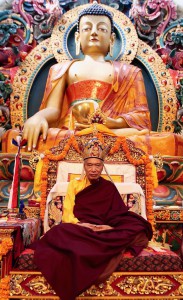
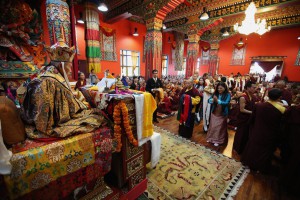
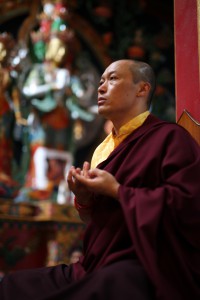
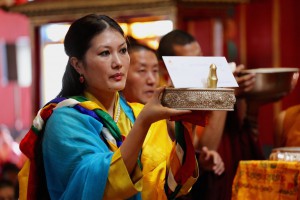
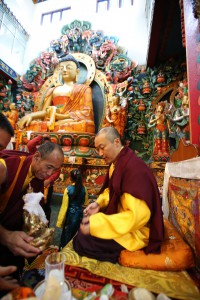
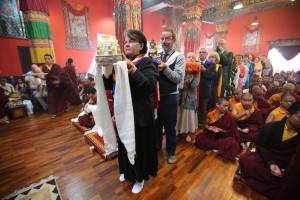
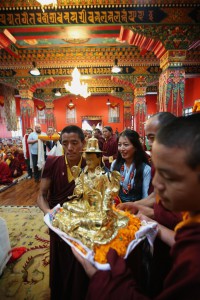
















Nov 27, 2015
Reply
Thank you for spreading the generosity even further, Walker. It’s much appreciated.
Nov 21, 2015
Reply
Dear Walker,
Thank you so much for writing up this whole series of articles about the Gongter. They have allowed me to feel the wonderful energy of generosity and awakenment from afar. I have also learned a lot about our lineage, thus they have been very educational. I appreciate the time and energy that was spent after what sounds like very long days, to benefit us at home. Thank you for your generous service to the community.
warmly, Lisa Aweida Ross
Nov 21, 2015
Reply
Thank you Walker! It is uplifting and inspiring to know the many ways generosity manifested at the Gongter.
Nov 21, 2015
Reply
Thank you — Beloved Sakyong for requesting and sponsoring the teachings!
Thank you Walker for sharing and teaching.
Thank you sangha for being there! Tashi Delek!
Nov 21, 2015
Reply
Thank you Walker.
We often never know how some of these generosities work.
Another example from the Gongter was first thing in the morning everyone received a cup of Tibetan medicine tea provided by the Tibetan doctors. There was also a clinic set up for anyone the whole time which many people used.
Nov 20, 2015
Reply
I hope you are intending to write up your experiences in further detail in an ebook like you did last time!